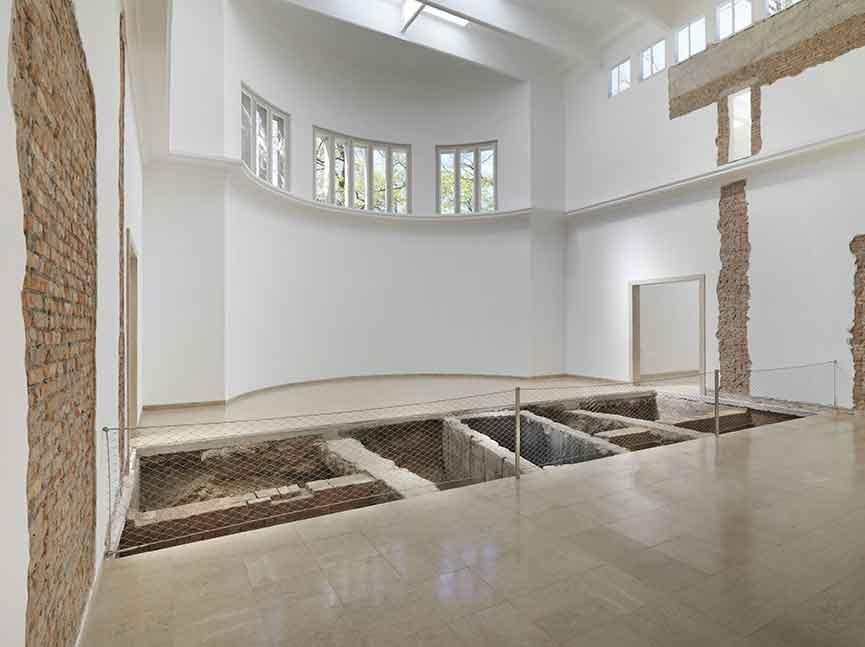
Italian Pavilion at Venice Biennale of Art - Arsenale, Castello - City of Venice
Exhibition in progress from April 23rd to November 27th 2022
The 59th Biennale Arte will open to the public on 23 April. But on the 20th, 21st and 22nd there will be the various openings and collateral events that always suddenly animate the Venetian artistic life. The awards ceremony will take place on the day of the opening to the public.
The title of the 59th edition of the Biennale d'Arte is Il Latte dei Sogni that means The Milk of Dreams.
The invited artists are 213 from 58 countries. There are 26 Italian artists, 180 the first participations in the International Exhibition, 1433 the works and objects on display, 80 new productions.
In all, 80 nations will participate in the Venice Biennale in the pavilions at the Giardini, the Arsenale and in the historic center of Venice.
Go to the page of the 59th Venice Art Biennale
Deutsch Pavilion, Germany at 59th Biennale Arte of Venice
The title of the exhibition at the Saudi Arabia Pavilion is The Teaching Tree | The learning tree.
Artists: Maria Eichhorn.
Curators: Yilmaz Dziewior.
Seat: Germany Pavilion, Giardini - Venice
Press Release of Deutsch Pavilion
The artist Maria Eichhorn has been invited by curator Yilmaz Dziewior to create the German
contribution to the 59th International Art Exhibition � La Biennale di Venezia.
In her project Relocating a Structure. German Pavilion 2022, 59th International Art
Exhibition � La Biennale di Venezia, Maria Eichhorn examines the eventful history of the
German Pavilion since the beginnings of the Biennale and the powerful resistance art
demonstrates when it focuses on social conditions.
Relocating a Structure consists of a number of interacting components. Eichhorn�s initial
idea was to relocate the German Pavilion for the duration of the Biennale and then to faithfully reassemble it on its original site. The temporary relocation of the building would leave an empty space, increasing the undeveloped area of the Giardini, originally designed as a
public park, as well as the visual and spatial environment around the adjacent pavilions. The
German Pavilion�s absence would open up space for movement, reflection, and an examination of the conditions to which art is exposed in the context of the Biennale with its national
pavilions.
The German Pavilion represents a challenge for artists on several completely different levels. With every attempt at deconstruction, one is confronted with it yet
again. I regard the German Pavilion not as isolated, but as part of an ensemble
and engaged in interplay with other pavilions and other country participations
in terms of national-territorial and geopolitical, global-economic, and ecological developments.
� Maria Eichhorn
Eichhorn�s reflections on the relocation of the German Pavilion were accompanied by an
analysis of the actual physical structure of the pavilion, which principally consists of two
buildings: the Bavarian Pavilion built in 1909 and the extensions carried out by the Nazis in
1938, as seen today. Where is the original structure located? Where do the extensions and
the reconstruction begin?
Eichhorn had the foundations of the pavilion excavated and layers of plaster removed
from its walls to expose the joins between the earlier structure and the remodeled building.
In order to comprehend the radical reconstruction and extension work, she also had the
outlines of the window openings and doorways from 1909 laid bare. In this way, the original,
hidden pavilion has been rendered visible and tangible.
Explanatory wall texts have been added to the exposed areas in English, German, and
Italian. The texts were drawn on the wall using pencil and stencils to create fine outlines that
were then filled in using a brush and white paint.
Not only were the transitions between the original architecture and the extension and
reconstruction work revealed, but also the shift in dimensions. While the proportions of
the Bavarian Pavilion were oriented to a human scale, the 1938 additions to the side rooms,
the main room, and especially the facade dwarf visitors, producing an intimidating effect.
The other components of Relocating a Structure include a comprehensive publication
and guided tours to historical places of resistance and remembrance in Venice, conducted
twice weekly during the Biennale. The publication brings together essays and studies on the
history of the Biennale and the German Pavilion, as well as on broader aspects embracing
art history, philosophy, urban sociology, and politics. In addition, a brochure has been published to accompany the guided tours of places commemorating the anti-fascist resistance
and the deportation and murder of the Jewish population during the German occupation
from 1943 to 1945. For these tours, Eichhorn collaborated with the Istituto veneziano per la
storia della Resistenza e della societ� contemporanea (Iveser).
The title of Maria Eichhorn�s project, Relocating a Structure, can be interpreted
in a figurative sense. �Relocating a structure� to a new context may refer not
only to the architecture and history of the German Pavilion, but also to fundamental issues of human existence and ethical responsibility.
� Yilmaz Dziewior
The German contribution to the 59th International Art Exhibition � La Biennale di Venezia
is realized on behalf of the Federal Foreign Office and in cooperation with ifa � Institut fu�r
Auslandsbeziehungen.
Useful information for the visit
Hours:
Gardens from 10.00 to 19.00. Arsenale from 10.00 to 19.00 (from 10.00 to 20.00 on Friday and Saturday until September 30th). Closed on Mondays (except May 13, September 2, November 18).
Tickets: please visit the official website.
Phone: +39.041.5218711; fax +39.041.5218704
E-mail: aav@labiennale.org
Web: Biennale
of Venice |
